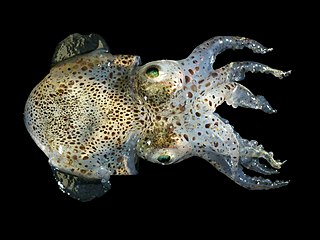
Bobtail squid are a group of cephalopods closely related to cuttlefish. Bobtail squid tend to have a rounder mantle than cuttlefish and have no cuttlebone. They have eight suckered arms and two tentacles and are generally quite small.

Loliginidae, commonly known as pencil squids, is an aquatic family of squid classified in the order Myopsida.

Euprymna tasmanica, also known as the southern dumpling squid or southern bobtail squid, is a bobtail squid that lives in the shallow temperate coastal waters of southern Australia's continental shelf. It lives for between 5 and 8 months and the adults can grow up to 6 or 7 cm long with a mantle length of 3 to 4 cm. They are found in seagrass beds or areas with soft silty or muddy bottoms from Brisbane on the east coast to Shark Bay on the west, as well as around Tasmania. Southern dumpling squid are nocturnal and during the day hide in sand or mud covered in a mucus-lined coat of sediment. If disturbed acid glans can quickly remove this coat as an additional decoy to ink squirting.
Liguriella is a genus of glass squids, the genus is probably monotypic, the only species being Liguriella podophthalma. The other named species Liguriella pardus, which was described by S. Stillman Berry in 1916, is cited as a taxon inquirendum but it is suggested that there may be in fact more than one species and there are species yet to be described.
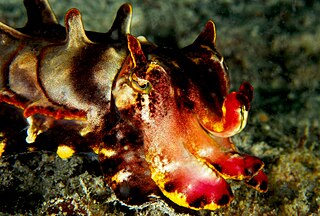
Metasepia pfefferi, also known as the flamboyant cuttlefish, is a species of cuttlefish occurring in tropical Indo-Pacific waters off northern Australia, southern New Guinea, as well as numerous islands of the Philippines, Indonesia and Malaysia.
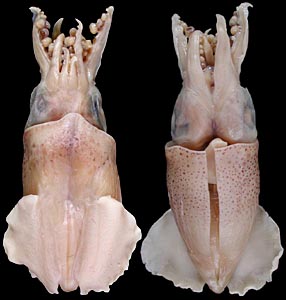
A. aldrichi is a small species of squid found in northern Australian waters. The species was described by Chung Cheng Lu in 2005 based on specimens collected in the inshore waters of Northern Australia. The largest known individual of this species is a mature female measuring 27.6 mm (1.09 in) in mantle length (ML). The holotype is a mature male of 21.3 mm (0.84 in) ML. A live specimen of A. aldrichi has yet to be recorded.
Euprymna hyllebergi, the Thai bobtail squid is a species of squid belonging to the family Sepiolidae and is native to the eastern Indian Ocean. It is commonly found in the Andaman Sea of Thailand and in the Gulf of Thailand. E. hyllebergi can grow up to 35mm in mantle length and can be found in depths as low as 74m. The Thai bobtail squid is covered in chromatophores, which are pigmented cells that can expand or contract and are used to camouflage the squid. The normal lifespan of the Thai bobtail squid is between 92 and 122 days for males and between 80 and 113 days for females.

Sepiola atlantica, also known as the Atlantic bobtail, is a species of bobtail squid native to the northeastern Atlantic Ocean and the Mediterranean Sea.
Stigmatoteuthis arcturi, commonly known as the jewelled squid, is a species of cock-eyed squid from the family Histioteuthidae. It occurs throughout the subtropical and tropical Atlantic Ocean in the mesopelagic zone.
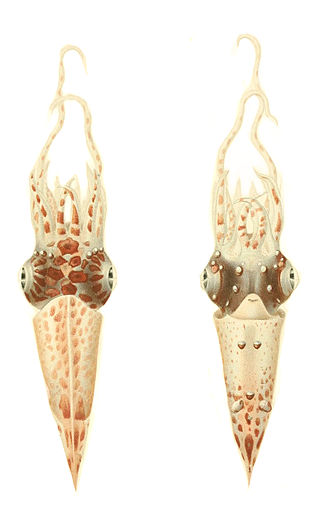
Pterygioteuthis giardi is a species of squid in the family Pyroteuthidae. It is known as the roundear enope squid. The specific name honors the French zoologist and marine biologist Alfred Mathieu Giard (1846-1908).

Counter-illumination is a method of active camouflage seen in marine animals such as firefly squid and midshipman fish, and in military prototypes, producing light to match their backgrounds in both brightness and wavelength.

Heteroteuthis dispar, also known as the odd bobtail, is a small deep water squid found in the North Atlantic Ocean and the Mediterranean Sea.

Illex coindetii, commonly known as the southern shortfin squid or broadtail shortfin squid, is a species of neritic squids in the family Ommastrephidae. They are found in the Mediterranean Sea and on both sides of the north Atlantic Ocean.

Abralia veranyi is a species of squid in the family Enoploteuthidae. Common names include the eye-flash squid, Verany's enope squid and the midwater squid. It is found in the Atlantic Ocean and the Mediterranean Sea. It undergoes a daily vertical migration from deep waters to near the surface.

Uroteuthis is a genus of 14 species of common inshore squids of the Indo-West Pacific and is further subdivided into 3 subgenera. The members of the genus Uroteuthis are the only squids of the family Loliginidae that possess photophores and all species in the genus have a pair of photophore organs on the ventral surface of their ink sac either side of their intestine.
Macrochlaena winckworthi, Winckworth's octopus, is a little known species of octopus, it is the only species in the monotypic genus Macrochlaena, in the family Octopodidae. It was described by the British malacologist Guy Coburn Robson in 1926, the type specimens having been collected in the Gulf of Mannar, off Thoothukudi in Tamil Nadu, southeastern India.
Afrololigo mercatoris, commonly known as the Guinean thumbstall squid, is a small species of squid in the family Loliginidae from the eastern central Atlantic Ocean. It is the only species in the monotypic genus Afrololigo.
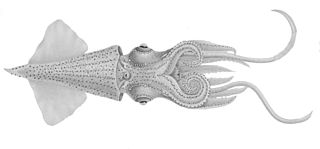
Enoploteuthis leptura, the hooked enope squid, is a species of squid from the family Enoploteuthidae. It is the type species of the genus Enoploteuthis, which is in turn the type genus of the Enoploteuthidae.
Eucleoteuthis is a monotypic genus of squid from the family Ommastrephidae; the only species is Eucleoteuthis luminosa, the striped flying squid or luminous flying squid.
Ornithoteuthis volatilis, the shiny bird squid, is a squid from the subfamily Ommastrephinae, the flying squids, of the family Ommastrephidae part of the pelagic squid order Oegopsida. It is a tropical and sub-tropical species which is widely distributed in the Indo-Pacific oceans. It is slightly larger than the closely related species Ornithoteuthis antillarum of the Atlantic Ocean.












